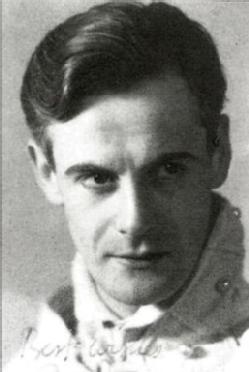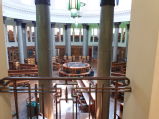2017-18 Recipients of the Dr Greg Wells Small Research Awards
Maria Krnić (Theatre and Performance Studies Department PhD)
In the period from the 18th May to the 21st June I visited Croatia for the purpose of the fieldwork research for my PhD thesis entitled ‘Performing Martyrdom: Theatre and Community in the East Adriatic Saints’ Plays’.
Given that an important part of my analysis is grounded in historical reconstruction of the performances of the saints’ plays, the archival research occupies a central place in my research. I have conducted the majority of the archival research during the first and the second year of my PhD studies. I have already recorded documents from: the state archive in Zadar which contains the majority of the archival documents related to the life of Dalmatian civic confraternities, the organizations responsible for performances, and from the church archives from the island of Hvar, the island which is geographically the focal point of my research. Nevertheless, during my analysis there appeared a need for additional sources from the archives of the convents. The Centre for the Study of the Renaissance Greg Wells Small Research Award supported financially my visit to those archives. I have used the £180 to cover the traveling costs for my return trip from the UK to Croatia.
During my stay at the island of Hvar I visited the Archbishops Archive in Hvar, and the archive of the Dominican Monastery in Stari Grad. While many documents which I have recorded in the archives helped me further reconstruct the social and cultural context in which the performances took place, one document I found especially important. In the Dominican Monastery, among the group of documents entitled Le cose varie (Different Things) I found the text entitled L’ Opera Di San Lorenzo (The Play of Saint Lawrence). After a close examination of the text I have discovered that the text in question is the Play of Life and Martyrdom of Saint Lawrence, the most popular Dalmatian saint play. The text was used as script for the performance in the nineteenth century which can be concluded by the well elaborated explicit stage directions, and language in which the directions were written (Italian/different from the language of the play) which was common for the early modern performances of medieval genres. This finding is important for my thesis because it will help me reconstruct the historical performances of the saints’ plays. Moreover, this finding will also contribute to the broader knowledge of European drama.
Julian Richards
Glen Byam Shaw (1904-1986) was an actor/director whose work shaped British Theatre and Shakespeare across the last century. Shaw is notable from a research perspective for having made detailed pre-production notebooks for all of the Shakespeare productions he directed. From 1947-51 he directed the Old Vic Theatre School. Shaw became co-director of the Shakespeare Memorial Theatre in 1952, first with Anthony Quayle and then alone. There he directed 14 plays, revitalised the Shakespeare Memorial Theatre, brought in major figures to direct productions, oversaw productions including Tony Richardson’s Othello, directed As You Like It to begin in winter and progress to summer for the first time, and selected Peter Hall to succeed him in 1959. Hall established the RSC a year later, building on Shaw’s foundation.
My thesis seeks to serve as the first major biographical investigation of Shaw. No full biography of Shaw exists, despite the fact that almost all of his contemporaries and friends have been extensively biographed and studied. Shaw’s influence on British theatre is not accurately reflected by the amount of scholarship surrounding him. Shaw was key to the development of post-war Shakespeare and was also the key architect of what would become the RSC. His work at the Shakespeare Memorial Theatre; revitalising the theatre’s output, bringing in both renowned, established names and up and coming practitioners; gave Peter Hall the opportunity to build on that legacy in the RSC. A case could be made for Shaw being the most significant figure in post-war Shakespeare. This thesis looks to fill that gap in the scholarship of the histories of both post-war Shakespeare studies and the RSC.
This grant allowed me to undertake a research trip to Cambridge University Library where letters between Shaw and Siegfried Sassoon are held. These letters date from the early 1920s through to the late 1960s and detail the relationship between the two men as well as the events of their lives over that period. Getting access to these letters and being able to take the time to properly explore them allowed me to not only read them but transcribe those most relevant to my researches.
From this trip I was able to gather evidence of Shaw's personal, uncensored opinion of his own work and time as director of the Shakespeare Memorial Theatre. I gained insight into his mindset at the outset of the Second World War and into how it affected him. This also gave me a window into how his directorial work was informed by his military and wartime experiences, understandings and prejudices. I also gathered supporting evidence of Shaw's bisexuality and the ways in which it may, or may not, have affected his directorial decisions.
The research outcome of this trip was invaluable to my thesis and will help to make a significant and important contribution to a much neglected area of renaissance and Shakespearean historiography through the lense of performance studies. This trip would not have been possible without the Greg Wells Research Award grant and I am very grateful for it.

Glen Byam Shaw
Sophie Shorland
I used this funding to visit Special Collections at the Brotherton library in Leeds. It enabled me to stay in the city for five days, spent viewing manuscript MS Lt q 32, which an attractive gold-tooled, calfskin volume containing the only surviving work of seventeenth century poet Hester Pulter. Her work was only discovered in 1992, so a great deal of scholarship remains to be done in order to contextualise, analyse and disseminate her work.
Being able to access the original document enabled me to read some marks and evidence of corrections that are not clear from either the digitised version, or the current printed edition of Hester Pulter’s complete work. These corrections are in her own hand, and therefore offer very important evidence of Pulter’s poetic process. As I am particularly interested in her language, it is incredibly important to work out which are Pulter’s deliberate corrections, and which features are in the scribe’s hand. Some of her corrections increase the repetition of particular words or phrases running through the poem (rather than excising repetition, as one might expect of the editorial process). This supports my thesis that Pulter’s poetry deliberately resists contemporary notions of ‘the right way to grieve’, instead repeating language to show the real form of grief, in which the bereaved often wishes to repeat information about the deceased. There is a gender distinction here: women generally talk through their grief, while men will more often retreat, spending time alone. In the short term, men can therefore often be seen publicly to be coping ‘better’ than women, but this approach can cause longer-term problems. Hester Pulter’s insistence on repeating her grief, and her use of rhetorical forms in which to articulate this grief, speak in a fascinating way to these gender differences. These ideas are based on therapeutic practices and cognitive behavioural science, and my current project attempts to position the two alongside a study of early modern rhetoric. I am planning to write this as an article for the journal Advances in Early Modern Rhetoric, and hope to have a draft version completed over the summer.
I have yet to attend the Literary Form After Matter conference at Queen’s College, Oxford, but I hope to develop these ideas further there. It is promising that this conference even exists, and hopefully signals a rejuvenated study of language. I give the undergraduate lecture and sometimes teach the seminars on Hester Pulter and Katherine Philips (another seventeenth century poet) every year at Warwick, and hope to incorporate this research into my pedagogical practice. Female writers like Philips and Pulter are often read biographically, so tying them into the issue of grief is a useful way for students to access the text, without needing to focus on the ‘homely’ or ‘domestic’ elements of their poetry.
I would also like to note how useful this grant was in terms of making connections, simply through being in a new place: I discovered a Calverley Road in Leeds, supporting an idea I have already stated in my PhD thesis about the Calverley family’s continued influence in the North of England long after the Renaissance. Similarly, the Brotherton Library’s special exhibition on Gipsy culture also provoked a new reading of a text I had been struggling with. The trip also had the unexpected benefit of being a complete break from worrying about the litany of other daily tasks. Being able to spend time in the beautiful Brotherton and see Leeds’ Victoriana at its best was a privilege.

Brotherton Library, Leeds
